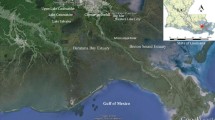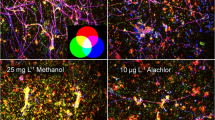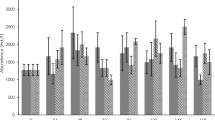Abstract
Extensive pesticide use for agriculture can diffusely pollute aquatic ecosystems through leaching and runoff events and has the potential to negatively affect non-target organisms. Atrazine and S-metolachlor are two widely used herbicides often detected in high concentrations in rivers that drain nearby agricultural lands. Previous studies focused on concentration-response exposure of algal monospecific cultures, over a short exposure period, with classical descriptors such as cell density, mortality or photosynthetic efficiency as response variables. In this study, we exposed algal biofilms (periphyton) to a concentration gradient of atrazine and S-metolachlor for 14 days. We focused on fatty acid composition as the main concentration-response descriptor, and we also measured chlorophyll a fluorescence. Results showed that atrazine increased cyanobacteria and diatom chlorophyll a fluorescence. Both herbicides caused dissimilarities in fatty acid profiles between control and high exposure concentrations, but S-metolachlor had a stronger effect than atrazine on the observed increase or reduction in saturated fatty acids (SFAs) and very long-chain fatty acids (VLCFAs), respectively. Our study demonstrates that two commonly used herbicides, atrazine and S-metolachlor, can negatively affect the taxonomic composition and fatty acid profiles of stream periphyton, thereby altering the nutritional quality of this resource for primary consumers.






Similar content being viewed by others
References
Bach L, Gissot L, Marion J, Tellier F, Moreau P, Satiat-Jeunemaître B, Palauqui J-C, Napier JA, Faure J-D (2011) Very-long-chain fatty acids are required for cell plate formation during cytokinesis in Arabidopsis thaliana. J Cell Sci 124:3223–3234. https://doi.org/10.1242/jcs.074575
Bachetti RA, Urseler N, Morgante V, Damilano G, Porporatto C, Agostini E, Morgante C (2021) Monitoring of Atrazine pollution and its spatial-seasonal variation on surface water sources of an agricultural river basin. Bull Environ Contam Toxicol 106:929–935. https://doi.org/10.1007/s00128-021-03264-x
Battaglin WA, Furlong ET, Burkhardt MR, Peter CJ (2000) Occurrence of sulfonylurea, sulfonamide, imidazolinone, and other herbicides in rivers, reservoirs and groundwater in the Midwestern United States, 1998. Sci Total Environ 248:123–133. https://doi.org/10.1016/S0048-9697(99)00536-7
Battaglin WA, Thurman EM, Kalkhoff SJ, Porter SD (2003) Herbicides and transformation products in surface waters of the midwestern United States. J Am Water Resour Assoc 39:743–756. https://doi.org/10.1111/j.1752-1688.2003.tb04402.x
Baxter L, Brain RA, Lissemore L, Solomon KR, Hanson ML, Prosser RS (2016) Influence of light, nutrients, and temperature on the toxicity of atrazine to the algal species Raphidocelis subcapitata: implications for the risk assessment of herbicides. Ecotoxicol Environ Saf 132:250–259. https://doi.org/10.1016/j.ecoenv.2016.06.022
Böger P (2003) Mode of action for chloroacetamides and functionally related compounds. J. Pestic. Sci. 28:324–329. https://doi.org/10.1584/jpestics.28.324
Boulêtreau S, Garabetian F, Sauvage S, Sanchez-Perez J-M (2006) Assessing the importance of a self-generated detachment process in river biofilm models. Freshw Biol 51:901–912. https://doi.org/10.1111/j.1365-2427.2006.01541.x
Brain RA, Anderson JC (2019) The agro-enabled urban revolution, pesticides, politics, and popular culture: a case study of land use, birds, and insecticides in the USA. Environ Sci Pollut Res 26:21717–21735. https://doi.org/10.1007/s11356-019-05305-9
Brett M, Müller‐Navarra D (1997) The role of highly unsaturated fatty acids in aquatic foodweb processes. Freshw Biol 38:483–499. https://doi.org/10.1046/j.1365-2427.1997.00220.x
Cattaneo A, Amireault MC (1992) How artificial are artificial substrata for periphyton? J N Am Benthol Soc 11:244–256. https://doi.org/10.2307/1467389
Chesworth JC, Donkin ME, Brown MT (2004) The interactive effects of the antifouling herbicides Irgarol 1051 and Diuron on the seagrass Zostera marina (L.). Aquat Toxicol 66:293–305. https://doi.org/10.1016/j.aquatox.2003.10.002
Chèvre N, Vallotton N (2013) Pulse exposure in ecotoxicology. In: Férard J-F, Blaise C (eds) Encyclopedia of aquatic ecotoxicology. Springer Netherlands, Dordrecht, pp. 917–926. https://doi.org/10.1007/978-94-007-5704-2_84
Coquillé N, Jan G, Moreira A, Morin S (2015) Use of diatom motility features as endpoints of metolachlor toxicity. Aquat Toxicol 158:202–210. https://doi.org/10.1016/j.aquatox.2014.11.021
Da Costa F, González-Araya R, Robert R (2023) Using combinations of microalgae to condition European flat oyster (Ostrea edulis) broodstock and feed the larvae: effects on reproduction, larval production and development. Aquaculture 568:739302. https://doi.org/10.1016/j.aquaculture.2023.739302
de Albuquerque FP, de Oliveira JL, Moschini-Carlos V, Fraceto LF (2020) An overview of the potential impacts of atrazine in aquatic environments: Perspectives for tailored solutions based on nanotechnology. Sci Total Environ 700:134868. https://doi.org/10.1016/j.scitotenv.2019.134868
Debenest T, Pinelli E, Coste M, Silvestre J, Mazzella N, Madigou C, Delmas F (2009) Sensitivity of freshwater periphytic diatoms to agricultural herbicides. Aquat Toxicol 93:11–17. https://doi.org/10.1016/j.aquatox.2009.02.014
DeLorenzo ME, Lauth J, Pennington PL, Scott GI, Ross PE (1999) Atrazine effects on the microbial food web in tidal creek mesocosms. Aquat Toxicol 46:241–251. https://doi.org/10.1016/S0166-445X(98)00132-5
Demailly F, Elfeky I, Malbezin L, Le Guédard M, Eon M, Bessoule J-J, Feurtet-Mazel A, Delmas F, Mazzella N, Gonzalez P, Morin S (2019) Impact of diuron and S-metolachlor on the freshwater diatom Gomphonema gracile: complementarity between fatty acid profiles and different kinds of ecotoxicological impact-endpoints. Sci Total Environ 688:960–969. https://doi.org/10.1016/j.scitotenv.2019.06.347
Desvilettes CH, Bourdier G, Amblard CH, Barth B (1997) Use of fatty acids for the assessment of zooplankton grazing on bacteria, protozoans and microalgae. Freshw Biol 38:629–637. https://doi.org/10.1046/j.1365-2427.1997.00241.x
Downing HF, Delorenzo ME, Fulton MH, Scott GI, Madden CJ, Kucklick JR (2004) Effects of the agricultural pesticides atrazine, chlorothalonil, and endosulfan on South Florida microbial assemblages. Ecotoxicology 13:245–260. https://doi.org/10.1023/B:ECTX.0000023569.46544.9f
Drerup SA, Vis ML (2016) Responses of Stream biofilm phospholipid fatty acid profiles to acid mine drainage impairment and remediation. Water Air Soil Pollut 227:159. https://doi.org/10.1007/s11270-016-2856-5
Egorova EA, Bukhov NG (2006) Mechanisms and functions of photosystem I-related alternative electron transport pathways in chloroplasts. Russ J Plant Physiol 53:571–582. https://doi.org/10.1134/S1021443706050013
European Commission (2004) Commission Regulation (EC) No 775/2004 of 26 April 2004 amending Annex I to Regulation (EC) No 304/2003 of the European Parliament and of the Council concerning the export and import of dangerous chemicals (Text with EEA relevance), CE.
Fadhlaoui M, Laderriere V, Lavoie I, Fortin C (2020) Influence of temperature and nickel on algal biofilm fatty acid composition. Environ Toxicol Chem 39:1566–1577. https://doi.org/10.1002/etc.4741
FAO (2022) Pesticides use pesticides trade and pesticides indicators. FAO. https://doi.org/10.4060/cc0918en
Filimonova V, Gonçalves F, Marques JC, De Troch M, Gonçalves AMM (2016) Fatty acid profiling as bioindicator of chemical stress in marine organisms: a review. Ecol Indic 67:657–672. https://doi.org/10.1016/j.ecolind.2016.03.044
Flemming H-C, Wingender J (2010) The biofilm matrix. Nat Rev Microbiol 8:623–633. https://doi.org/10.1038/nrmicro2415
Fortier A (2018) Règlement modifiant le Code de gestion des pesticides 5.
Gao Y, Fang Jianguang, Li W, Wang X, Li F, Du M, Fang Jinghui, Lin F, Jiang W, Jiang Z (2019) Effects of atrazine on the physiology, sexual reproduction, and metabolism of eelgrass (Zostera marina L.). Aquat Botany 153:8–14. https://doi.org/10.1016/j.aquabot.2018.10.002
Garg N, Manchanda G (2009) ROS generation in plants: boon or bane? Plant Biosyst 143:81–96. https://doi.org/10.1080/11263500802633626
Genter RB, Lehman RM (2000) Metal toxicity inferred from algal population density, heterotrophic substrate use, and fatty acid profile in a small stream. Environ Toxicol Chem 19:869–878. https://doi.org/10.1002/etc.5620190413
George SD, Ernst AG, Baldigo BP, Honeyfield DC (2016) Response of periphyton fatty acid composition to supplemental flows in the upper Esopus Creek, Catskill Mountains, New York: U.S. Geological Survey Scientific Investigations Report (Scientific Investigations Report). U.S. Geological Survey, Reston, Virginia. https://doi.org/10.3133/sir20155161
Giddings JM, Campana D, Nair S, Brain R (2018) Data quality scoring system for microcosm and mesocosm studies used to derive a level of concern for atrazine: atrazine microcosm and mesocosm data quality scoring. Integr Environ Assess Manag 14:489–497. https://doi.org/10.1002/ieam.4050
Gladyshev MI, Sushchik NN, Anishchenko OV, Makhutova ON, Kolmakov VI, Kalachova GS, Kolmakova AA, Dubovskaya OP (2011) Efficiency of transfer of essential polyunsaturated fatty acids versus organic carbon from producers to consumers in a eutrophic reservoir. Oecologia 165:521–531. https://doi.org/10.1007/s00442-010-1843-6
Glinski DA, Purucker ST, Van Meter RJ, Black MC, Henderson WM (2018) Analysis of pesticides in surface water, stemflow, and throughfall in an agricultural area in South Georgia, USA. Chemosphere 209:496–507. https://doi.org/10.1016/j.chemosphere.2018.06.116
Gonçalves AMM, Rocha CP, Marques JC, Gonçalves FJM (2021) Fatty acids as suitable biomarkers to assess pesticide impacts in freshwater biological scales—a review. Ecol Indic 122:107299. https://doi.org/10.1016/j.ecolind.2020.107299
Green JW, Springer TA, Holbech H (2018) Statistical Analysis of Ecotoxicity Studies, 1st edn. John Wiley & Sons, Hoboken, NJ
Griffini O, Bao ML, Barbieri D, Pantani F (1997) Occurrence of pesticides in the arno river and in potable water—a survey of the period 1992-1995. Bull Environ Contam Toxicol 59(2):202–209
Groner ML, Relyea RA (2011) A tale of two pesticides: how common insecticides affect aquatic communities: a tale of two pesticides. Freshw Biol 56:2391–2404. https://doi.org/10.1111/j.1365-2427.2011.02667.x
Gugger M (2002) Cellular fatty acids as chemotaxonomic markers of the genera Anabaena, Aphanizomenon, Microcystis, Nostoc and Planktothrix (cyanobacteria). Int J Syst Evolut Microbiol 52:1007–1015. https://doi.org/10.1099/ijs.0.01917-0
Hansen SP, Messer TL, Mittelstet AR (2019) Mitigating the risk of atrazine exposure: identifying hot spots and hot times in surface waters across Nebraska, USA. J Environ Manag 250:109424. https://doi.org/10.1016/j.jenvman.2019.109424
HRAC (2020) Global herbicide classification lookup. Herbicide Resistance Action Committee
Huggins K, Frenette J-J, Arts MT (2004) Nutritional quality of biofilms with respect to light regime in Lake Saint-Pierre (Quebec, Canada). Freshw Biol 49:945–959. https://doi.org/10.1111/j.1365-2427.2004.01236.x
Kabra AN, Ji M-K, Choi J, Kim JR, Govindwar SP, Jeon B-H (2014) Toxicity of atrazine and its bioaccumulation and biodegradation in a green microalga, Chlamydomonas mexicana. Environ Sci Pollut Res 21:12270–12278. https://doi.org/10.1007/s11356-014-3157-4
Kapsi M, Tsoutsi C, Paschalidou A, Albanis T (2019) Environmental monitoring and risk assessment of pesticide residues in surface waters of the Louros River (N.W. Greece). Sci Total Environ 650:2188–2198. https://doi.org/10.1016/j.scitotenv.2018.09.185
King RS, Brain RA, Back JA, Becker C, Wright MV, Toteu Djomte V, Scott WC, Virgil SR, Brooks BW, Hosmer AJ, Chambliss CK (2016) Effects of pulsed atrazine exposures on autotrophic community structure, biomass, and production in field-based stream mesocosms: pulsed atrazine exposures. Environ Toxicol Chem 35:660–675. https://doi.org/10.1002/etc.3213
Konschak M, Zubrod JP, Duque Acosta TS, Bouchez A, Kroll A, Feckler A, Röder N, Baudy P, Schulz R, Bundschuh M (2021) Herbicide-induced shifts in the periphyton community composition indirectly affect feeding activity and physiology of the gastropod grazer Physella acuta. Environ. Sci. Technol. 55:14699–14709. https://doi.org/10.1021/acs.est.1c01819
Lang I, Hodac L, Friedl T, Feussner I (2011) Fatty acid profiles and their distribution patterns in microalgae: a comprehensive analysis of more than 2000 strains from the SAG culture collection. BMC Plant Biol 11:124. https://doi.org/10.1186/1471-2229-11-124
Larras F, Billoir E, Baillard V, Siberchicot A, Scholz S, Wubet T, Tarkka M, Schmitt-Jansen M, Delignette-Muller M-L (2018) DRomics: a turnkey tool to support the use of the dose–response framework for omics data in ecological risk assessment. Environ. Sci. Technol. 52:14461–14468. https://doi.org/10.1021/acs.est.8b04752
Laviale M, Morin S, Créach A (2011) Short term recovery of periphyton photosynthesis after pulse exposition to the photosystem II inhibitors atrazine and isoproturon. Chemosphere 84:731–734. https://doi.org/10.1016/j.chemosphere.2011.03.035
LAWA (2019) Rapport sur la qualité des eaux souterraines—produits phytosanitaires. Länderarbeitsgemeinschaft Wasser (LAWA)—Sous-comité Produits phytosanitaires dans les eaux souterraines
Li H-Y, Lu Y, Zheng J-W, Yang W-D, Liu J-S (2014) Biochemical and genetic engineering of diatoms for polyunsaturated fatty acid biosynthesis. Mar Drugs 12:153–166. https://doi.org/10.3390/md12010153
Maltsev Y, Maltseva K (2021) Fatty acids of microalgae: diversity and applications. Rev Environ Sci Biotechnol 20:515–547. https://doi.org/10.1007/s11157-021-09571-3
Matthes B, Böger P (2002) Chloroacetamides affect the plasma membrane. Zeitschrift für Naturforschung C 57:843–852. https://doi.org/10.1515/znc-2002-9-1015
Melo A, Quintelas C, Ferreira EC, Mesquita DP (2022) The role of extracellular polymeric substances in micropollutant removal. Front. Chem. Eng. 4:778469. https://doi.org/10.3389/fceng.2022.778469
Morales M, Aflalo C, Bernard O (2021) Microalgal lipids: a review of lipids potential and quantification for 95 phytoplankton species. Biomass Bioenergy 150:106108. https://doi.org/10.1016/j.biombioe.2021.106108
Morin S, Pesce S, Tlili A, Coste M, Montuelle B (2010) Recovery potential of periphytic communities in a river impacted by a vineyard watershed. Ecol Indic 10:419–426. https://doi.org/10.1016/j.ecolind.2009.07.008
Muller R, Schreiber U, Escher BI, Quayle P, Bengtson Nash SM, Mueller JF (2008) Rapid exposure assessment of PSII herbicides in surface water using a novel chlorophyll a fluorescence imaging assay. Sci Total Environ 401:51–59. https://doi.org/10.1016/j.scitotenv.2008.02.062
Müller-Navarra DC, Brett MT, Liston AM, Goldman CR (2000) A highly unsaturated fatty acid predicts carbon transfer between primary producers and consumers. Nature 403:74–77. https://doi.org/10.1038/47469
Murdock JN, Shields FD, Lizotte RE (2013) Periphyton responses to nutrient and atrazine mixtures introduced through agricultural runoff. Ecotoxicology 22:215–230. https://doi.org/10.1007/s10646-012-1018-9
Nakamura Y, Li-Beisson Y (eds) (2016) Lipids in plant and algae development, subcellular biochemistry. Springer International Publishing, Cham. https://doi.org/10.1007/978-3-319-25979-6
Ou-Yang K, Feng T, Han Y, Li G, Li J, Ma H (2022) Bioaccumulation, metabolism and endocrine-reproductive effects of metolachlor and its S-enantiomer in adult zebrafish (Danio rerio). Sci Total Environ 802:149826. https://doi.org/10.1016/j.scitotenv.2021.149826
Pannard A, Le Rouzic B, Binet F (2009) Response of phytoplankton community to low-dose atrazine exposure combined with phosphorus fluctuations. Arch Environ Contam Toxicol 57:50–59. https://doi.org/10.1007/s00244-008-9245-z
Parlakidis P, Rodriguez MS, Gikas GD, Alexoudis C, Perez-Rojas G, Perez-Villanueva M, Carrera AP, Fernández-Cirelli A, Vryzas Z (2022) Occurrence of banned and currently used herbicides, in groundwater of Northern Greece: a human health risk assessment approach. IJERPH 19:8877. https://doi.org/10.3390/ijerph19148877
Perkins DB, Chen W, Jacobson A, Stone Z, White M, Christensen B, Ghebremichael L, Brain R (2021) Development of a mixed-source, single pesticide database for use in ecological risk assessment: quality control and data standardization practices. Environ Monit Assess 193:827. https://doi.org/10.1007/s10661-021-09596-9
Proia L, Morin S, Peipoch M, Romaní AM, Sabater S (2011) Resistance and recovery of river biofilms receiving short pulses of Triclosan and Diuron. Sci Total Environ 409:3129–3137. https://doi.org/10.1016/j.scitotenv.2011.05.013
Prosser RS, Brain RA, Hosmer AJ, Solomon KR, Hanson ML (2013) Assessing sensitivity and recovery of field-collected periphyton acutely exposed to atrazine using PSII inhibition under laboratory conditions. Ecotoxicology 22:1367–1383. https://doi.org/10.1007/s10646-013-1123-4
Quintaneiro C, Patrício D, Novais SC, Soares AMVM, Monteiro MS (2017) Endocrine and physiological effects of linuron and S-metolachlor in zebrafish developing embryos. Sci Total Environ 586:390–400. https://doi.org/10.1016/j.scitotenv.2016.11.153
Rea G, Polticelli F, Antonacci A, Scognamiglio V, Katiyar P, Kulkarni SA, Johanningmeier U, Giardi MT (2009) Structure-based design of novel Chlamydomonas reinhardtii D1-D2 photosynthetic proteins for herbicide monitoring. Protein Sci 18:2139–2151. https://doi.org/10.1002/pro.228
Relyea RA (2009) A cocktail of contaminants: how mixtures of pesticides at low concentrations affect aquatic communities. Oecologia 159:363–376. https://doi.org/10.1007/s00442-008-1213-9
Ricart M, Barceló D, Geiszinger A, Guasch H, Alda MLde, Romaní AM, Vidal G, Villagrasa M, Sabater S (2009) Effects of low concentrations of the phenylurea herbicide diuron on biofilm algae and bacteria. Chemosphere 76:1392–1401. https://doi.org/10.1016/j.chemosphere.2009.06.017
Rock CO (2008) Fatty acid and phospholipid metabolism in prokaryotes. In: Biochemistry of lipids, lipoproteins and membranes. Elsevier, pp 59–96. https://doi.org/10.1016/B978-044453219-0.50005-2
Rossoll D, Bermúdez R, Hauss H, Schulz KG, Riebesell U, Sommer U, Winder M (2012) Ocean acidification-induced food quality deterioration constrains trophic transfer. PLoS ONE 7:e34737. https://doi.org/10.1371/journal.pone.0034737
Roubeix V, Fauvelle V, Tison-Rosebery J, Mazzella N, Coste M, Delmas F (2012) Assessing the impact of chloroacetanilide herbicides and their metabolites on periphyton in the Leyre River (SW France) via short term growth inhibition tests on autochthonous diatoms. J. Environ. Monit. 14:1655. https://doi.org/10.1039/c2em10887a
Schmitt-Jansen M, Altenburger R (2005) Predicting and observing responses of algal communities to photosystem ii–herbicide exposure using pollution-induced community tolerance and species-sensitivity distributions. Environ Toxicol Chem 24:304. https://doi.org/10.1897/03-647.1
Sénat de France, 2003. Annexe 47 (Atrazine) du rapport d’office parlementaire sur la qualité de l’eau et assainissement en France.
Shanta PV, Li B, Stuart DD, Cheng Q (2021) Lipidomic Profiling of Algae with Microarray MALDI-MS toward Ecotoxicological Monitoring of Herbicide Exposure. Environ. Sci. Technol. 55:10558–10568. https://doi.org/10.1021/acs.est.1c01138
Shen P-L, Wang H-T, Pan Y-F, Meng Y-Y, Wu P-C, Xue S (2016) Identification of characteristic fatty acids to quantify triacylglycerols in microalgae. Front. Plant Sci 7. https://doi.org/10.3389/fpls.2016.00162
Špoljarić Maronić D, Štolfa Čamagajevac I, Horvatić J, Žuna Pfeiffer T, Stević F, Žarković N, Waeg G, Jaganjac M (2018) S-metolachlor promotes oxidative stress in green microalga Parachlorella kessleri - A potential environmental and health risk for higher organisms. Sci Total Environ 637–638:41–49. https://doi.org/10.1016/j.scitotenv.2018.04.433
Székács A, Mörtl M, Darvas B (2015) Monitoring pesticide residues in surface and ground water in Hungary: surveys in 1990–2015. J Chem 2015:1–15. https://doi.org/10.1155/2015/717948
Thakkar M, Randhawa V, Wei L (2013) Comparative responses of two species of marine phytoplankton to metolachlor exposure. Aquat Toxicol 126:198–206. https://doi.org/10.1016/j.aquatox.2012.10.002
Thompson FL, Abreu PC, Wasielesky W (2002) Importance of biofilm for water quality and nourishment in intensive shrimp culture. Aquaculture 203:263–278. https://doi.org/10.1016/S0044-8486(01)00642-1
Trbojević I, Jovanović J, Kostić D, Popović S, Krizmanić J, Karadžić V, Subakov Simić G (2017) Structure and succession of periphyton in an urban reservoir: artificial substrate specificity. Oceano Hydrobiol Stud 46:379–392. https://doi.org/10.1515/ohs-2017-0038
USEPA (2017) Pesticides industry sales and usage, 2008–2012 Market estimates. United States Environmental Protection Agency.
USEPA (2016) Refined ecological risk assessment for atrazine. United States Environmental Protection Agency.
Vallotton N, Moser D, Eggen RIL, Junghans M, Chèvre N (2008) S-metolachlor pulse exposure on the alga Scenedesmus vacuolatus: effects during exposure and the subsequent recovery. Chemosphere 73:395–400. https://doi.org/10.1016/j.chemosphere.2008.05.039
Vryzas Z, Alexoudis C, Vassiliou G, Galanis K, Papadopoulou-Mourkidou E (2011) Determination and aquatic risk assessment of pesticide residues in riparian drainage canals in northeastern Greece. Ecotoxicol Environ Saf 74:174–181. https://doi.org/10.1016/j.ecoenv.2010.04.011
Wetzel RG (ed) (1983) Periphyton of Freshwater Ecosystems: Proceedings of the First International Workshop on Periphyton of Freshwater Ecosystems held in Växjö, Sweden, 14–17 September 1982. Springer Netherlands, Dordrecht. https://doi.org/10.1007/978-94-009-7293-3
WSSA (2021) WSSA-Herbicide Site of Action (SOA) Classification List. Weed Science Society of America.
Zemolin CR, Avila LA, Cassol GV, Massey JH, Camargo ER (2014) Environmental fate of S-Metolachlor: a review. Planta Daninha 32:655–664. https://doi.org/10.1590/S0100-83582014000300022
Acknowledgements
The authors would like to thank Stéphane Moïse from the general laboratory at INRS-ETE for his help on herbicide analysis. We would also like to thank Nolan Pearce for English revisions as well as the Groupe de recherche interuniversitaire en limnologie (GRIL).
Funding
We would like to thank the Fonds de recherche du Québec (FRQNT) for a grant to IL (FRQNT Relève professorale; 2021-NC-285440) and the Centre de recherche en écotoxicologie du Québec (EcotoQ) for funding to LM.
Author information
Authors and Affiliations
Contributions
All authors made substantial contributions to this paper. L.M. was in charge of experimental conceptualization, laboratory experiments, sample collection, data analysis, and writing. S.M. was involved in experimental conceptualization, project management, reviewing, and editing. I.L. was responsible for funding acquisition project administration and was involved in the project conception, experimental conceptualization, reviewing, and editing.
Corresponding author
Ethics declarations
Conflict of interest
The authors declare no competing interests.
Supplementary Information
Rights and permissions
Springer Nature or its licensor (e.g. a society or other partner) holds exclusive rights to this article under a publishing agreement with the author(s) or other rightsholder(s); author self-archiving of the accepted manuscript version of this article is solely governed by the terms of such publishing agreement and applicable law.
About this article
Cite this article
Malbezin, L., Morin, S. & Lavoie, I. Effects of atrazine and S-metolachlor on stream periphyton taxonomic and fatty acid compositions. Ecotoxicology 33, 190–204 (2024). https://doi.org/10.1007/s10646-024-02738-y
Accepted:
Published:
Issue Date:
DOI: https://doi.org/10.1007/s10646-024-02738-y




